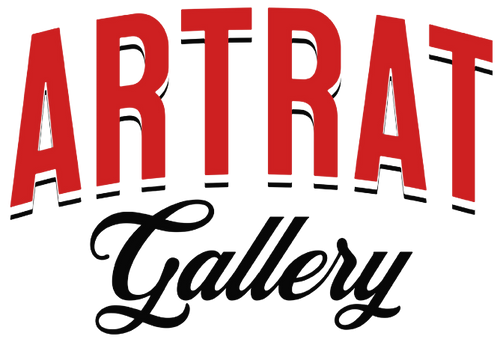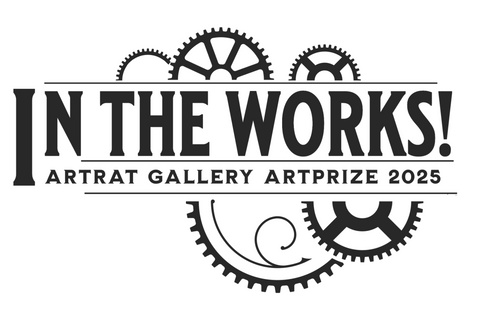Sunday, Sept. 17, ArtRat Gallery presented Americana Sunday: An Afternoon With Nic Gareiss. This is a very special event for ArtRat: Nic is returning to the gallery for the first weekend of ArtPrize 2023 after making his ArtRat debut at last year’s festival.
It was also the weekend of our Heartside neighborhood’s first-ever Heart Prize celebration — so ArtRat is covering ticket costs for the afternoon!
One of Dance Magazine’s “25 to Watch,” Nic Gareiss (he/they) is swiftly becoming recognized for his singular voice in the realm of dance, music and the traditional arts. This mix of movement, instrumental melodies, and traditional songs from rural places has become the heart of Nic's creative work.
Informed by 25 years of ethnographic study and performance, Gareiss’ work draws from many percussive dance practices to weave together a technique facilitating his love of improvisation; clog, flatfoot and step-dance vocabulary; and musical collaboration.
Ahead of the show, ArtRat asked Nic about the perspectives that inform his performance.
We're catching you right after Wheatland 2023. How was the festival for you? (And how many years have you been attending?)
Wheatland was so enjoyable this year, and very nostalgic given that it was the 50th anniversary of the first annual festival! A great lineup (including Jake Blount, Ruthie Foster, Lone Piñon and the Onlies!); we had a full dance floor for the step dance workshop I gave; our panel discussion on making traditional arts spaces more inclusive (expertly facilitated by Gray Reynolds) was lively; and most of all, we had uproariously fun sets with my collaborator for the weekend, the incredible banjo player Allison de Groot!
I started attending Wheatland in 1997, and this weekend was extra-special because my first clogging teacher, Sheila Graziano, received the Michigan Heritage Award, the highest honor bestowed on traditional artists in our state.
I met Sheila at Wheatland years ago, and she taught me my first Appalachian dance steps, even gave me one of my first gigs at the Saline Celtic Festival with Jeremy Kittel, Sean Gavin and Michael Gavin. Micah Ling from the Michigan Traditional Arts Program had the brilliant idea to present Sheila's award at the festival. It was so cool to be present to see Sheila celebrated for her contributions to the traditional arts in our state.
Your interests combine ethnography and dance, including an MA in ethnochoreology. How does your social science training inform the way you explore dance traditions and integrate them into your own performances?
I studied anthropology and music as an undergrad, and it was during a seminar with professor Athena McLean that I realized that dance can be a form of ethnography. I went to grad school for ethnochoreology at the University of Limerick in Ireland and did my fieldwork with LGBTQ Irish step dancers. The experience of moving with people, hearing them share their experiences as dancers, as queer people, and as traditional artists helped me think about the ways that dance and music serve as dynamic facets that shape people's ideas about their physical selves, about their culture or nationhood, and about their place in time.
In performance, I'm really excited about using movement and sound to ask questions around these facets, about finding the interstices between traditional dance practices, and about re-presenting cultural forms as ever expansive and inclusive for all bodies and orientations. Audiences will see and hear that if they come to the show Sunday!
You last appeared at ArtRat during ArtPrize 2022, when you joined other queer folk performers for a showcase. You shared some great insights about combining LGBTQIA+ perspectives with dance traditions that have not overtly embraced them. How significant is that dimension to your own work?
Hugely significant! When I grew up attending folk music and dance events, the square dances were taught with "gents and ladies," not allowing space for the many other genders or desires we know exist. I created a piece that I call "Solo Square Dance" as my own queer response to those customs. The piece uses the steps, shapes and verbal cues a dance caller shouts, bending them, flexing the registers of tempo, relationality and virtuosity of Appalachian dance to re-cast the traditional form as inclusive of all people.
I see the piece as reparative — it adjusts the language of dance calling to account for the fact that we queer people are indeed present in traditional forms like Appalachian dance, Irish step dance, old-time music, balladry and other folk forms.
You've toured globally and performed all over Michigan. What do you like about playing in Grand Rapids?
Despite having toured internationally for years (17 countries and counting!), I have not performed much in Grand Rapids. It's a place where I have experienced memorable and path-breaking art. I attended ArtPrize in 2012 and witnessed two astonishingly beautiful exhibits exploring disability, sexuality and gender by Robert Andy Coombs and Lora Robertson at the Fountain Street Church. Sam Amidon gave one of the most enjoyable and thought-provoking shows I've ever seen at the DAAC.
I'm curious about the city's capacity to encounter challenging work and share its ample resources with underrepresented artists. I can't wait to spend the afternoon in the Heartside neighborhood at ArtRat moving and sounding amidst the audiences of your city!





